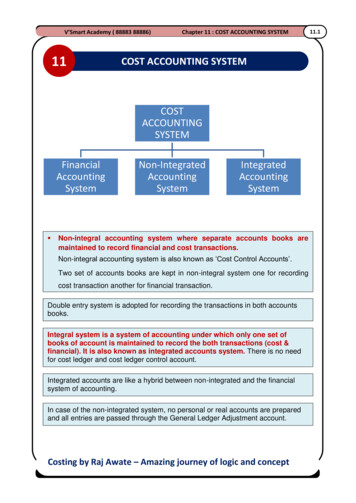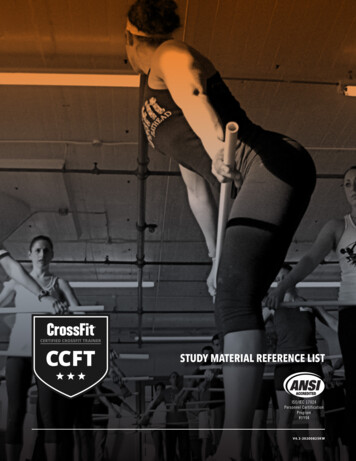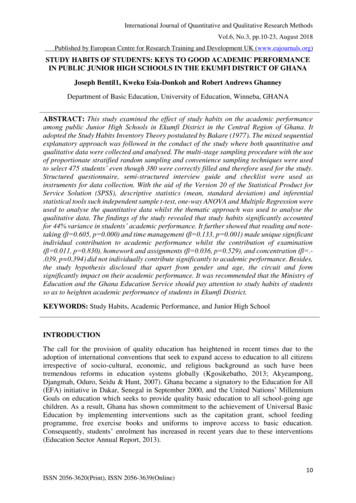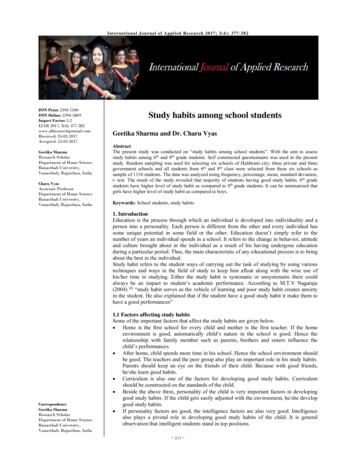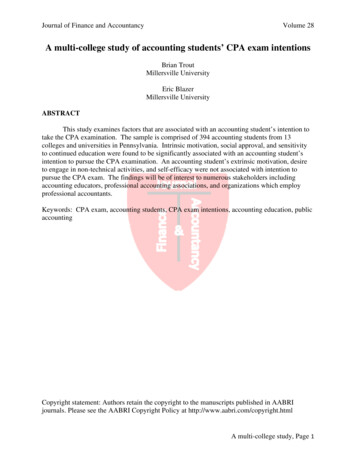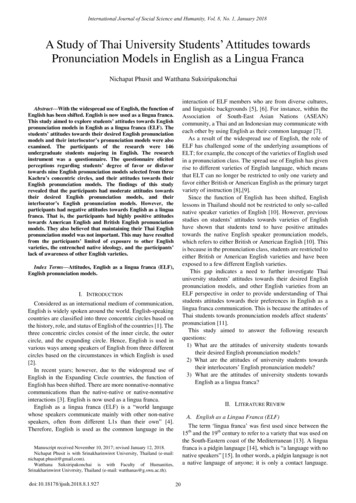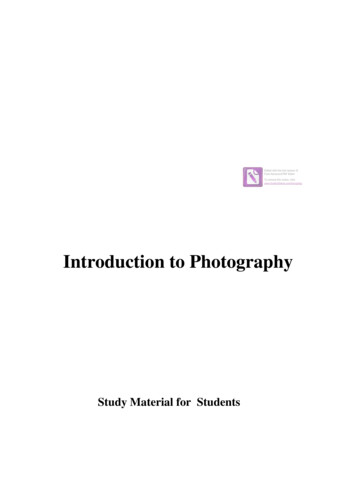
Transcription
Edited with the trial version ofFoxit Advanced PDF EditorTo remove this notice, visit:www.foxitsoftware.com/shoppingIntroduction to PhotographyStudy Material for Students
Edited with the trial version ofFoxit Advanced PDF EditorTo remove this notice, visit:www.foxitsoftware.com/shopping: Introduction to PhotographyCAREER OPPORTUNITIES IN MEDIA WORLDMass communication and Journalism is institutionalized and source specific.It functions through well-organized professionals and has an ever increasinginterlace. Mass media has a global availability and it has converted the wholeworld in to a global village. A qualified journalism professional can take up ajob of educating, entertaining, informing, persuading, interpreting, andguiding. Working in print media offers the opportunities to be a newsreporter, news presenter, an editor, a feature writer, a photojournalist, etc.Electronic media offers great opportunities of being a news reporter, newseditor, newsreader, programme host, interviewer, cameraman, producer,director, etc.Other titles of Mass Communication and Journalism professionals are scriptwriter, production assistant, technical director, floor manager, lightingdirector, scenic director, coordinator, creative director, advertiser, mediaplanner, media consultant, public relation officer, counselor, front officeexecutive, event manager and others.2
Edited with the trial version ofFoxit Advanced PDF EditorTo remove this notice, visit:www.foxitsoftware.com/shopping: Introduction to PhotographyINTRODUCTIONThe book will introduce the student to the techniques of photography. The bookdeals with the basic steps in photography. Students will also learn the differenttypes of photography. The book also focuses of the various parts of a photographiccamera and the various tools of photography. Students will learn the art of taking agood picture.The book also has introduction to photojournalism and the basic steps of filmdevelopment in photography.3
Edited with the trial version ofFoxit Advanced PDF EditorTo remove this notice, visit:www.foxitsoftware.com/shoppingIntroduction to PhotographyINDEX402 Introduction to PhotographyI. INTRODUCTION5-331.1 Photography;1.2 Photographic Camera & Types of camera1.3 Camera; Parts of a Camera1.3.1 Shutter1.4 Kinds of Photography,1.4.1 Infrared Photography1.4.2 Ultraviolet Photography1.4.3. High-speed Photography1.4.4. Aerial Photography1.4.5 Digital Photography1.4.6. The Invention of Photography1.4.7. The Daguerreotype1.4.8. The Calotype1.4.9. The Collodion Process1.4.10. The Impact of Early Photography1.4.11. Further Developments1.5 History & Development of Photography,1.6 Tools of Photography,1.6.1. Photography StylesUNIT 2. PHOTOJOURNALISM2.1. Role of Photojournalism2.2. Importance of Photojournalism2.3. Elements of Photography2.4. Point of Interest2.5. Rule of Thirds2.6. Role of Visualizations2.7. Photographer’s jargon2.8. Photographic equipment: Choice of Cameras2.9. The Role Film and the Cut Film2.10. Compositions2.11. Cameras and Photo:2.11.1. Shutter2.11.2 Film Format2.11.3 Basics of Film Speed2.11.4 Processing your Photo2.12. Photo editing433-57
Edited with the trial version ofFoxit Advanced PDF EditorTo remove this notice, visit:www.foxitsoftware.com/shoppingIntroduction to PhotographyUNIT 3. TYPES OF PHOTOS57-773.1. Portrait Photography3.2. Still Photography3.3. Wildlife Photography3.4. Disaster Photography3.5. Sports Photography3.6. Political Photography3.7. Weather & Environment Photography3.8. War Photography3.9. Advertising Photography3.10. Landscape Photography3.11. Social Photography3.12. News PhotographyUNIT 4. NEWS VALUES FOR PICTURES:77-954.1. PHOTO ESSAY5.1 Photo Features5.2 Picture Magazines5.4 Color Photography5.5 Impact Of Technology5.6. Photography Lighting Techniques5.7. Film Development5.8. Photo Paper5.9. Chemicals And EquipmentSummeryQuestions for practiceSuggested Readings59599100
Edited with the trial version ofFoxit Advanced PDF EditorTo remove this notice, visit:www.foxitsoftware.com/shopping: Introduction to PhotographySYLLABUSIntroduction to PhotographyPhotography;Meaning,Definition & History of Photography,Tools of Photography,Camera; Parts of a Camera Shutter, Apertures, Lens, Films,Types of Camera,Quality of Photograph,Role of Visualizations,Shots,Roles of Lightings,How to take a good picture,Role of Subject,Editing & Development of Photograph.Manual & ComputerizedComposition of Photograph,Photo Journalism, its Role & Importance6
Edited with the trial version ofFoxit Advanced PDF EditorTo remove this notice, visit:www.foxitsoftware.com/shoppingIntroduction to PhotographyINTRODUCTION TO PHOTOGRAPHYOBJECTIVES to introduce the student to the techniques of photographyto deal with the basic steps in photographylearn the different types of photographyto know the various parts of a photographic camera and the various tools ofphotography to learn the art of taking a good picture. to introduce the students to photojournalism and the basic steps of filmdevelopment in photographyINTRODUCTIONPhotography is the process of forming stable or permanent visible imagesdirectly or indirectly by the action of light or other forms of radiation onsensitive surfaces. Traditional photography uses the action of light to causechanges in a film of silver halide crystals in which development converts exposedsilver halide to non -sensitive) metallic silver. Following exposure in a camera orother device, the film or plate is developed, fixed in a solution that dissolves theundeveloped silver halide, washed to remove the soluble salts, and dried. Printingfrom the original, if required, is done by contact or optical projection onto a secondemulsion-coated material, and a similar sequence of processing steps is followed.Digital photography captures images directly with an electronic photo sensor.1.1. Photography is the process of making pictures by means of capturing lighton a light-sensitive medium, such as a sensor or film. Light patterns reflected oremitted from objects are recorded onto a sensitive medium or storage chip througha timed exposure. The most common process is done through mechanical,chemical or digital devices known as cameras.7
Edited with the trial version ofFoxit Advanced PDF EditorTo remove this notice, visit:www.foxitsoftware.com/shopping: Introduction to PhotographyThe word comes from the Greek words phos "light", and graphis "stylus","paintbrush" or "representation by means of lines" or "drawing", togethermeaning "drawing with light." Traditionally the product of photography has beencalled a photograph. The term photo is an abbreviation; many people also call thempictures. In digital photography, the term image has begun to replace photographthe term image is traditional in geometric optics.1.2. Photographic CamerasThe camera is the image-formingdevice, and photographic film isthe recording medium. A cameraworks somewhat like the humaneye, capturing reflected lightfrom objects and through acamera lens and focusing thoselight rays into an image.Traditionally cameras recordedthe image onto film. Morerecentlythroughthedevelopment of computer chips,many cameras capture theirimages on a computer chip. Thecomputer chip then allows theconversion of the image todigital data. Regardless ofwhether the photography is film or digital-based, the images can be madepermanent and seen by an unlimited number of people.Photographers control the camera and lens to "expose" the light recording materialusually film or a charge-coupled device; a complementary metal-oxidesemiconductor may also be used to the required amount of light. After processing,this produces an image.Types of Camera SLR Single Lens Reflex : The viewfinder sees the same image as the mainlens, i.e. what you see is what you get. SLRs also allow you to changelenses for different purposes. This is a hugely popular type of camera, prettymuch the standard for enthusiasts and professionals.8
Edited with the trial version ofFoxit Advanced PDF EditorTo remove this notice, visit:www.foxitsoftware.com/shoppingntroduction to Photography Viewfinder or range f inder): In this type of camera the viewfinder isseparate to the lens. This is common in cheap cameras, although someprofessional cameras also use this configuration. The main problem with aseparate viewfinder is that the image you see may not be quite the same asthe image that gets recorded. This limitation is overcome in professionalcameras by using viewfinders that compensate for the different positions.Viewfinder cameras do have some advantages; for example, lower noise andhigher light levels to the viewfinder. Twin reflex: The camera has two lenses — one for the photograph and onefor the viewfinder. This type of camera has certain advantages in someprofessional situations. View: A flexible bellows joins two standards — one with the lens and theother with the viewfinder or film. This allows for unusual types ofcomposition; for example, distorting the shape of the image by skewing thefilm plane. Pinhole: A very simple camera without a lens.The controls usually include but are not limited to the following:Focus of the lens Aperture of the lens – adjustment of the iris, measured as f-number, whichcontrols the amount of light entering the lens. Aperture also has an effect onfocus and depth of field, namely, the smaller the opening aperture), the lesslight but the greater the depth of field--that is, the greater the range withinwhich objects appear to be sharply focused. Shutter speed – adjustment of the speed often expressed either as fractionsof seconds or as an angle, with mechanical shutters of the shutter to controlthe amount of time during which the imaging medium is exposed to light foreach exposure. Shutter speed may be used to control the amount of lightstriking the image plane; 'faster' shutter speeds that is, those of shorterduration decrease both the amount of light and the amount of imageblurring from subject motion or camera motion. White balance – on digital cameras, electronic compensation for the colortemperature associated with a given set of lighting conditions, ensuring thatwhite light is registered as such on the imaging chip and therefore that thecolors in the frame will appear natural. On mechanical, film-based cameras,this function is served by the operator's choice of film stock. In addition tousing white balance to register natural coloration of the image,9
Edited with the trial version ofFoxit Advanced PDF EditorTo remove this notice, visit:www.foxitsoftware.com/shoppingIntroduction to Photographyphotographers may employ white balance to aesthetic end, for examplewhite balancing to a blue object in order to obtain a warm color temperature. Metering – measurement of exposure at a midtone so that highlights andshadows are exposed according to the photographer's wishes. Many moderncameras feature this ability, though it is traditionally accomplished with theuse of a separate light metering device. ISO speed – traditionally used to set the film speed of the selected film onfilm cameras, ISO speeds are employed on modern digital cameras as anindication of the system's gain from light to numerical output and to controlthe automatic exposure system. A correct combination of ISO speed,aperture, and shutter speed leads to an image that is neither too dark nor toolight. Auto-focus point – on some cameras, the selection of a point in the imagingframe upon which the auto-focus system will attempt to focus. Many SLRsingle Lens Reflex cameras feature multiple auto-focus points in theviewfinder.Many other elements of the imaging device itself may have a pronounced effect onthe quality and/or aesthetic effect of a given photograph; among them are: Focal length and type of lens telephoto, macro, wide angle, or zoom Filters or scrims placed between the subject and the light recordingmaterial, either in front of or behind the lens Inherent sensitivity of the medium to light intensity and color/wavelengths. The nature of the light recording material, for example its resolution asmeasured in pixels or grains of silver halide.Camera controls are inter-related, the total amount of light reaching the film planethe "exposure" changes with the du ration of exposure, aperture of the lens, andfocal length of the lens which changes as the lens is zoomed. Changing any ofthese controls alters the exposure. Many cameras may be set to adjust most or allof these controls automatically. This automatic functionality is useful in manysituations, and in most situations to occasional photographers.The duration of an exposure is referred to as shutter speed, often even incameras that don't have a physical shutter, and is typically measured in fractions ofa second. Aperture is expressed by an f-number or f-stop derived from focal ratio,which is proportional to the ratio of the focal length to the diameter of the aperture.If the f-number is decreased by a factor of , the aperture diameter is increased bya factor of 2. The f-stops that might be10
Edited with the trial version ofFoxit Advanced PDF EditorTo remove this notice, visit:www.foxitsoftware.com/shoppingntroduction to Photographyfound on a typical lens include 2.8, 4, 5.6, 8, 11, 16, 22, 32, where going up "onestop" doubles the amount of light reaching the film, and stopping down one stophalves the amount of light.Exposures can be achieved through various combinations of shutter speed andaperture. For example, f/8 at 1/125th of a second and f/4 at 1/500th of a secondyield the same amount of light. The chosen combination has an impact on the finalresult. In addition to the subject or camera movement that might vary depending onthe shutter speed, the aperture and focal length of the lens determine the depth offield, which refers to the range of distances from the lens that will be in focus. Forexample, using a long lens and a large aperture f/2.8, for example), a subject'seyes might be in sharp focus, but not the tip of the nose. With a smaller aperturef/22, or a shorter lens, both the subject's eyes and nose can be in focus. With verysmall apertures, such as pinholes, a wide range of distance can be brought intofocus.Image capture is only part of the image forming process. Regardless of material,some process must be employed to render the latent image captured by the camerainto the final photographic work. This process consists of two steps,development, and printing.During the printing process, modifications can be made to the print by severalcontrols. Many of these controls are similar to controls during image capture, whilesome are exclusive to the printing process. Most controls have equivalent digitalconcepts, but some create different effects. For example, dodging and burningcontrols are different between digital and film processes. Other printingmodifications include: Chemicals and process used during film development Duration of exposure — equivalent to shutter speed Printing aperture — equivalent to aperture, but has no effect on depth offield Contrast Dodging — reduces exposure of certain print areas, resulting in a lighterareas Burning — increases exposure of certain areas, resulting in darker areas Paper quality — glossy, matte, etc1.3. PARTS OF CAMERA11
Edited with the trial version ofFoxit Advanced PDF EditorTo remove this notice, visit:www.foxitsoftware.com/shoppingIntroduction to PhotographyDespite advances in technology, the camera hasn't changed a whole lot, as far asmechanics go. A camera is essentially a light-tight box with a hole in it. Everythingelse is an elaboration. Here we’ll look in general how the box is arranged andwhere the elaborations usually are, for the 35mm SLR.The bodyThe body is the box, to which everything else is attached. Can be made from metal,plastic, space-age composite, wood, cardboard, or just about anything opaque. Aswell as the attaching point, the body holds the film. In the case of a view camera,the body is simply a frame which holds a film holder on one side and a bellows, orextendable tube on the other, which is attached to a separate lens-holding frame.ViewfinderThe viewfinder is what you look through to compose the picture. Most oftenintegral to the body, pro cameras have viewfinders that can be switched. Theviewfinder contains a lens, through which you look, a mirror, and a groundglass view screen, which again, in pro cameras, can be replaced or swapped fordifferent types. Most viewfinders only show some 85-90% of the scene, so watchyour edges, and get closer1.3.1. Shutter releaseUsually located on the right front as you hold the camera), the shutter release isthe button you push to, hey, release the shutter. The button may be threaded toaccept a cable release, which you attach as an extension, and use when you want toeliminate vibration. Mounted with the shutter release, at least on those old-timeycameras, is the film advance lever. Many newer cameras with auto winders built-indon't have a film advance lever.Shutter speed dialUsually located on the right front as you hold the camera), closer to theviewfinder. Many newer, electronic cameras don't have this dial, and you set theshutter speed using buttons or different dial, usually located near the release onthe body. The shutter speed dial will have a series of numbers, usually from 8 or 4to 1000 or 2000. These are shutter speeds, and are parts of a second. Also, you maysee A or P for automatic or program, T for time, which opens the shutter when youpress the release, and leaves it open until you press it again. B is the bulb setting,which keeps the shutter open for as long as you keep the release held down. Therewill also be a flash-sync speed, which is the speed setting for your camera whenusing a strobe.Rewind/ASA dial12
Edited with the trial version ofFoxit Advanced PDF EditorTo remove this notice, visit:www.foxitsoftware.com/shoppingIntroduction to PhotographyThis, at least on cameras without a built-in winder, is a kind of multi-functionknob. The upper part has a small flip-out crank, which is used in conjunction witha release button on the bottom of the body to rewind the film back into thecanister. Pull the crank up, and it releases the camera back, to load and unload film.The bottom part is the ASA, or film speed, setting. Pulling up on the outer ringallows you to rotate a dial to change the ASA setting. Cameras that do not haveeither of these will have a rewind switch, or rewind the film automatically whenyou reach the end of a roll. There will be a lever or release for the back, usually onthe side of the body. The ASA may be set automatically reading the DX codefrom the film canister, with an override available through the onboard computer.Lens releaseA button or lever which unlocks the lens for removal, the lens release is one of thefew controls on the front of the camera which hasn't been replaced by a selection inan LED menu. Work the release and twist the lens to remove, with bayonet-mountlenses. To replace the lens, line up the slots, or two dots one on the lens and oneon the body and twist until th e lens clicks into place. Do not force the lens! If it islined up properly, it should go right on.OthersWhile the above controls/parts are pretty much standard, there are more that areless so. The first is a depth of field preview. This is a button or lever, which whenmanipulated, will stop down the lens to the aperture setting selected, allowing youto look through the viewfinder and actually see the depth of field. An excellentthing, with one problem: many 35mm SLRs have viewfinders that are too smalland dim to see anything once you've stopped down past about ƒ/8. Another controlis a self-timer, a button or switch which will release the shutter after a giveninterval, so that you can be in those wonderful group pix with everyone else.Usually there is a socket for a sync cord a small double -circle), which is used toattach the camera to a strobe unit. There may be a manual shutter release, for usewhen batteries are well and truly gone.Cameras that do not have auto-advance and rewind usually have a small button onthe bottom of the body which must be depressed when rewinding the film. Thisbutton disengages the film advance drive mechanism. If you don’t hold this downand insist in rewinding the film, you will do one of several bad things: break therewind lever/handle, rip the film, and/or strip the gearingThe basic idea behind a photographic camera has not changed much since itsinvention, although new advancements such as digital technology have changed13
Edited with the trial version ofFoxit Advanced PDF EditorTo remove this notice, visit:www.foxitsoftware.com/shoppingntroduction to Photographythe art form. Knowing the mechanism behind a camera gives the photographer abetter understanding of the craft of photography.Casing and Viewfinder: The camera casing is the solid outer shell that providesprotection for the inner parts. The casing also helps keep light out of the camera,preventing light from exposing the film. The viewfinder is used by the cameraoperator to aim and focus the image and adjust the settings.Lens and Mirror: The lens allows light to enter the camera and focuses the lighton the film. It also allows light to reflect off the mirror, allowing the operator tosee the image to be photographed in the viewfinder. An image that is not focusedin the viewfinder will appear blurry when printed. The mirror is only in use whenthe shutter is closed. It allows the operator to see the image in the viewfinder toprepare the image to be photographed. When the shutter is opened, the mirrormoves up, allowing light to enter the camera and exposing the film to the lightedimage.Prism: The prism refracts light, allowing the operator to see the image in theviewfinder when the shutter is closed.Aperture and Shutter Speed Dial: The opening in the lens that controls theamount of light allowed into the camera and the length of time the film is exposedto light is called the aperture. The shutter speed dial is set by the camera operatorand regulates how long the aperture stays open. The slower the shutter speed, themore light the aperture allows into the camera; a slow shutter speed would be setaround 60.F-Stop Ring and ASA Dial: The F-Stop ring has settings from 2 to 22, with 2being the largest and 22 the smallest. These settings are for the size of the apertureopening when the picture is taken; the smaller the setting, the less light is allowedinto the camera to expose the film. The ASA dial is set according to the speed ofthe film used in the camera. Faster film is used for fast-moving action and lowlight levels; a film with a setting of 200 or above is classified as fast.Film Advance Lever, Rewind Crank and Frame Advance Box: The filmadvance lever is used to advance the film through the camera. The frame advancebox displays the number of pictures taken and helps the operator judge how manypictures are left on a roll of film. The rewind crank is used when a roll of film isfinished and is used to rewind the exposed film back into the canister.Uses of PhotographyPhotography is practiced on a professional level for portraiture and for variouscommercial and industrial applications, including the preparation of photographsfor advertising, illustration, display, and record-keeping. Press photography is for14
Edited with the trial version ofFoxit Advanced PDF EditorTo remove this notice, visit:www.foxitsoftware.com/shoppingIntroduction to Photographynewspaper and magazine illustrations of topical events and objects. Photography isused at several levels in the graphic arts to convert original photographs or otherillustrations into printing plates for high-quality reproduction in quantity. Industrialphotography includes the generation and reproduction of engineering drawings,high-speed photography, and many other forms of technical photography, whichcan aid in the development, design, and manufacture of various products. Aerialphotography is used for military investigation and mapping, civilian mapping,urban and highway planning, and surveys of material resources. Biomedicalphotography is used to reveal or record biological structures, often of significancein medical research, diagnosis, or treatment. Photography is widely applied topreparing projection slides and other displays for teaching through visualeducation.Photography is one of the most important tools in scientific and technical fields. Itextends the range of vision, allowing records to be made of things or events whichare difficult or impossible to see because they are too faint, too brief, too small, ortoo distant, or associated with radiation to which the eye is insensitive. Technicalphotographs can be studied at leisure, measured, and stored for reference orsecurity. The acquisition and interpretation of images in scientific and technicalphotography usually requires direct participation by the scientist or skilledtechnicians.1.4. KINDS OF PHOTOGRAPHYInfrared PhotographyEmulsions made with special sensitizing dyes can respond to radiation atwavelengths up to 1200 nanometers, though the most common infrared filmsexhibit little sensitivity beyond 900 nm. One specialized color film incorporates alayer sensitive in the 700–900-nm region and is developed to false colors to showinfrared-reflecting subjects as bright red.15
Edited with the trial version ofFoxit Advanced PDF EditorTo remove this notice, visit:www.foxitsoftware.com/shoppingntroduction to PhotographyPhotographs can thus be made of subjects, which radiate in the near-infrared, suchas stars, certain lasers and light-emitting diodes, and hot objects with surfacetemperatures greater than 500 F 260 C). Infrared films are more commonly usedto photograph subjects, which selectively transmit or reflect near-infraredradiation, especially in a manner different from visible radiation. Infraredphotographs taken from long distances or high altitudes usually show improvedclarity of detail because atmospheric scatter haze is diminished with increasingwavelength and because the contrast of ground objects may be higher as a result oftheir different reflectance in the near-infrared. Grass and foliage appear whitebecause chlorophyll is transparent in the near-infrared, while water is renderedblack because it is an efficient absorber of infrared radiation.Ultraviolet PhotographyTwo distinct classes of photography rely on ultraviolet radiation. In the first, therecording material is exposed directly with ultraviolet radiation emitted, reflected,or transmitted by the subject; in the other, exposure is made solely with visibleradiation resulting from the fluorescence of certain materials when irradiated in theultraviolet. In the direct case, the wavelength region is usually restricted by thecamera lens and filtration to 350–400 nm, which is readily detected with16 Y
Edited with the trial version ofFoxit Advanced PDF EditorTo remove this notice, visit:www.foxitsoftware.com/shoppingntroduction to Photographyconventional black-and-white films. Ultraviolet photography is accomplished atshorter wavelengths in spectrographs and cameras fitted with ultraviolettransmitting or reflecting optics, usually with specialized films. In ultravioletfluorescence photography, ultraviolet radiation is blocked from the film byfiltration over the camera lens and the fluorescing subject is recorded readily withconventional color or panchromatic films. Both forms of ultraviolet photographyare used in close-up photography and photomicrography by mineralogists,museums, art galleries, and forensic photographers.High-speed PhotographyPhotography at exposure durations shorter than those possible with conventionalshutters or at frequencies frame rates greater than those achievable with motionpicture cameras with intermittent film movements is useful in a wide range oftechnical applications.17
Edited with the trial version ofFoxit Advanced PDF EditorTo remove this notice, visit:www.foxitsoftware.com/shoppingntroduction to PhotographyAerial PhotographyThe art of aerial photography, in which photographs of the Earth's surface aremade with specialized roll-film cameras carried aloft on balloons, airplanes, andspacecraft, is an important segment of a broader generic technology, remotesensing. The film is often replaced with an electronic sensor, the sensor systemmay be mounted on an aircraft or spacecraft, and the subject may be the surface ofa distant planet instead of Earth. Remote sensing is used to gather militaryintelligence; to provide most of the information for plotting maps; for evaluatingnatural resources minerals, petroleum, soils, crops, and water and naturaldisasters; and for planning cities, highways, dams, pipelines, and airfields. Aerialphotography normally provides higher ground resolution and geometric accuracythan the imagery obtained with electronic sensors, especially when covering smallareas, so it continues as the foundation for mapmaking, urban planning, and someother applications.Digital PhotographyThe process of electronic acquisition, the equivalent of taking a photograph, isoften referred to as image capture.18
Edited with the trial version ofFoxit Advanced PDF EditorTo remove this notice, visit:www.foxitsoftware.com/shopping: Introduction to PhotographyLight intensity is detected in digital camera by a photo sensor. This is normally acharge-coupled device CCD, although complementary metal oxide siliconCMOS) devices are beginning to appear in some systems.When photons strike the sensor, they give up energy. This causes electrons to beemitted, turning the energy of the photons into electrical energy. The number ofelectrons that are emitted can be measured to determine how many photons struckthe capture element, and from this the scanner can generate a value for the intensityof light arriving from the point on the original being analyzed.The
The book will introduce the student to the techniques of photography. The book deals with the basic steps in photography. Students will also learn the different . Definition & History of Photography, Tools of Photography, Camera; Parts of a Camera Shutter, Apertures, Lens, Films, Types

